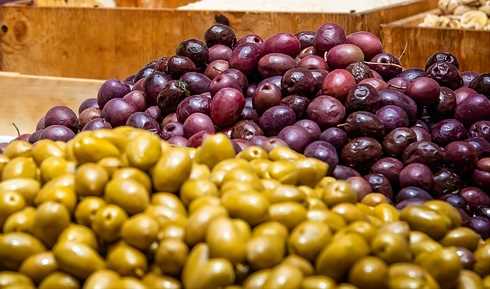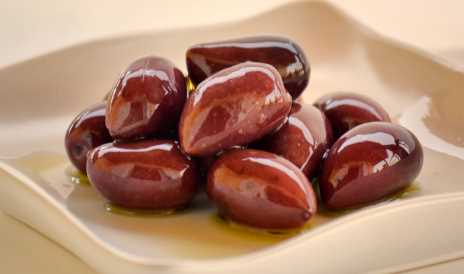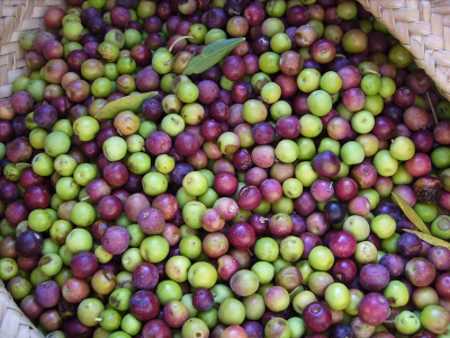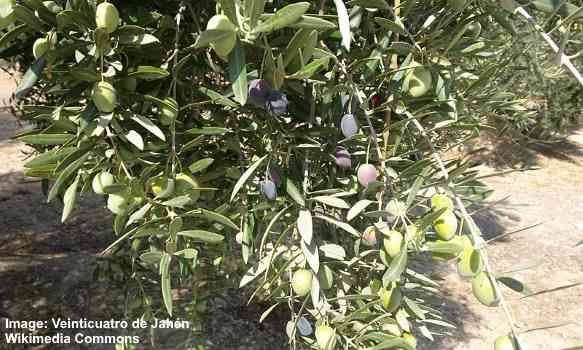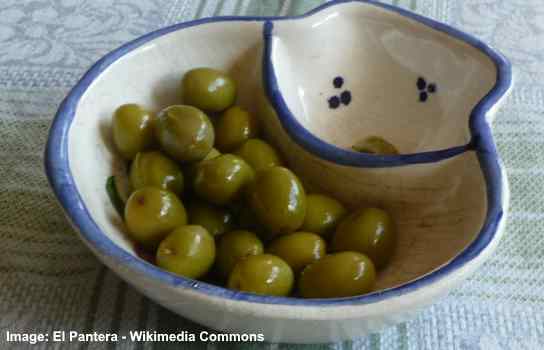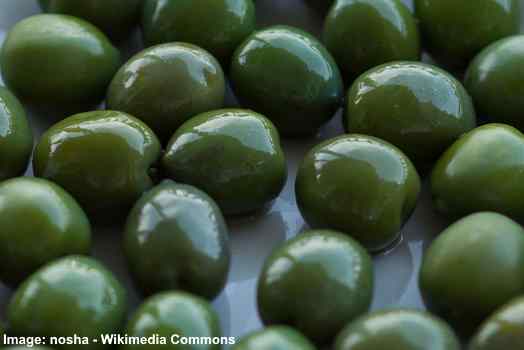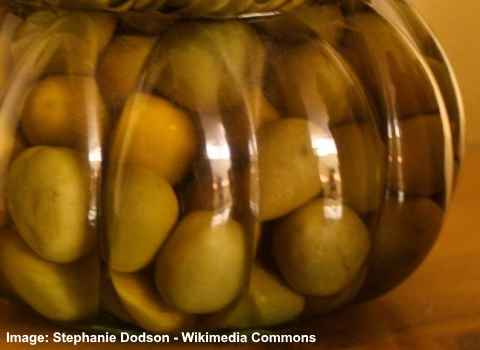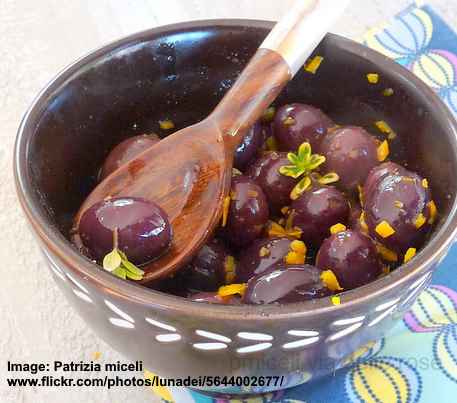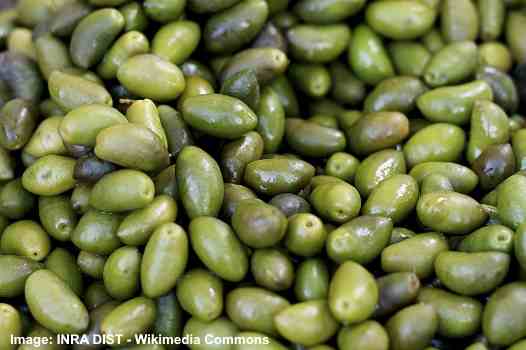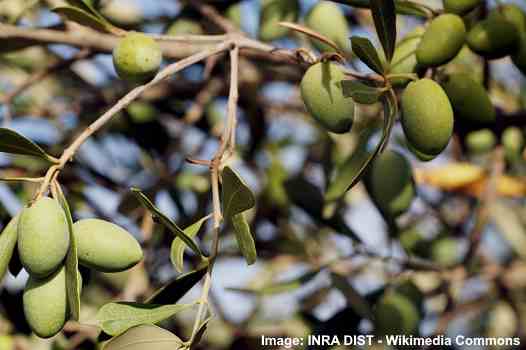Types of Olives: 28 Tasty Varieties of Olives You Should Try
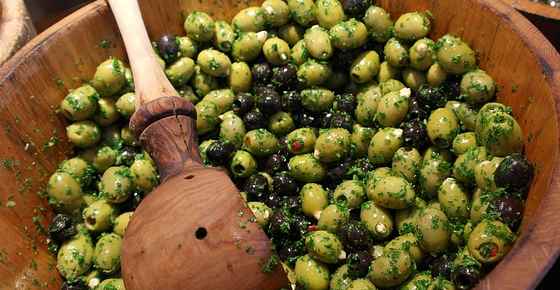
Olives are a type of fruit that grows on olive trees and are very healthy for you. There are hundreds of varieties of olives that mainly grow in countries around the Mediterranean but they also grow in other locations such as California. Spain, Greece, and Italy are the largest producers of green olives, purple olives, and black olives. The salty, bitter, and sometimes fruity taste of olives is mainly due to preserving techniques used to cure olives.
The hundreds of varieties of olive trees are not only prized for their delicious olive fruits but also for their wood and leaves. In fact, it is said that some types of olive trees are over 1,660 years old and are still producing delicious tasty olives!
If you have only tried some cheap bland-tasting pitted olives that are commercially produced, then you should try some of the tasty types of olives mentioned in this article.
Green Olives vs. Black Olives
Many people assume that green olives and black olives are different types of olives from different varieties of olive trees.
However, all kinds of olives – green, black, purple, and reddish/purple – are the same type of olive fruit from the same tree. The difference between green and black olives depends on the ripeness when the olive was picked.
As olives ripen, they turn from green to a light red and then purple before becoming black. Green olives are ready for picking in September and October. By late November and December, the harvest season is really underway when soft, ripe, black olives are ready for harvesting.
The question of whether to eat green olives or black varieties of olives is all down to personal taste. Green olives tend to be harder and have a more bitter taste. Black olives are softer and have a sweeter taste. However, storing the olives in brine, vinegar, olive oil, or drying them also affects the taste and texture of all type of olives.
Types of Olives
Let’s look at some of the most popular types of olives that you can eat to give your food a delicious Mediterranean twist.
Kalamata Olives
Kalamata olives are one of the tastiest and most popular types of Greek olives.
These reddish-purple olives are grown in the Kalamata region in the south of Greece. Olives from Kalamata can also be brown olives, purple olives, or black olives.
Kalamata olives have a protected designation of origin (PDO) status, meaning that olives marketed as “Kalamata” must be from this region.
Because Kalamata olives contain a lot of oil, olive producers also use this olive variety to press olive oil. However, their salty-sweet flavors make these olives great for using as table olives.
Kalamata Greek olives are generally cured in brine or red wine vinegar. They go well with feta cheese, roasted vegetables, or as a tapenade.
Agrinion Olives
Olives from the Agrinion region of Greece are another popular and tasty variety of Greek olive.
Agrinion olives are fruits from the Conservelea tree which is said to be one of the oldest varieties of olive trees in the world.
Agrinion olives are sold as green olives or black olives, and come in varying shapes and sizes. These Greek olives are cured in brine where they develop a tangy, sour taste. Usually, these olives are sold with the pit which separates easily from the firm juicy flesh.
Amfissa Olives
Amfissa olives are green or black olives that grow in Central Greece and they also have PDO status.
It is said that there are over 1.2 million olives trees in the Amfissa region of Greece.
Olives grown in the Amfissa region grow on the same type of olive tree as Agrinion olives – the Conservelea tree. The climate where they grow causes them to have a sweeter and fruitier taste than other olive fruits.
Depending on when they are harvested, these olives can be small in size. However, fully ripe Amfissa olives are fleshy and meaty with a fruity taste.
Black or green Amfissa olives make great tables olives and are also used for producing olive oil.
Halkidiki Olives
Halkidiki olives are large green olives that are from the Halkidiki region in Greece.
Because this type of Greek olive is so big, it is sometimes called the “donkey olive.”
Halkidiki olives generally have a bright green color that becomes yellow the more the fruit matures. Halkidiki olives are cured in salted brine to help lose the bitter taste of raw olives. As they ferment in the brine, these bright green olives develop a slightly spicy taste with hints of fruity aromas.
For some people, Halkidiki olives are the perfect Greek olive and are viewed as one of the best table olives.
Arauco Olives
Arauco is a type of dark green olive that grows in the La Rioja region of Spain or in the Arauco region of Argentina.
This large type of olive is harvested when it is still green and then cured in brine. To enhance its flavor, olive producers often use rosemary in the curing liquid.
The large fleshy olive is often used to make olive oil which produces a fruity oil that has a spicy aftertaste. You can also use Arauco olives as a table olive to enjoy its pleasant salty taste.
Arbequina Olives
Arbequina olives are one of the most popular varieties of olives from Spain. They have become such a popular type of olive that these olive trees now grow in South America, Australia, and the U.S.
These small brown or dark orange olives are cured in brine to enhance their fruity flavor. Because they contain a lot of oil, most of the olive production is used to make olive oil.
They also make great table olives because of their light mild flavor.
Manzanilla Olives
Coming from Spain, Manzanilla olives are one of the most famous types of Spanish olives. This small green olive fruit is prepared using sea salt brine.
If you have ever tried pitted green olives in brine bought from a store, then chances are that you tasted Manzanilla olives. These are the most commonly sold olives you can buy that are stuffed with pimento or garlic.
Due to the high production of these olives, Spanish Manzanilla olives are also one of the most important sources of Spanish olive oil.
Gordal Olives
Gordal olives are large plump green fruits from the Andalucía region of Spain. In fact, they are the largest type of olives to grow in Spain.
This large “jumbo” olive is a popular table olive due to its delicious firm flesh that tastes mild and slightly salty. The green olive has a definite crunch when you bite into it.
Due to the fact that Gordal olives are not a variety of an “oily olive,” they are not used to produce olive oil.
Because of their large size, Gordal olives are also sold stuffed with cheese, peppers, or fruit and are a popular addition to tapas.
Picual Olives
Picual olives are one of the most popular olives to use in olive oil production. In fact, it is rare to find Picual olives to buy as whole fruits.
Despite the fact that these are small olives, one-quarter of the world’s olive oil comes from Picual olives. The reason why this type of Spanish olive is so good for producing oil is that the fruit weight is up to 27% oil. (1)
Extra virgin olive oil pressed from Picual olives is an extremely rich source of healthy fatty acids and polyphenols. (1)
Verdial Olives
Verdial olives are a sweet type of olive fruit that is distinguished by its bright green color.
Bright green Verdial olives are great as table olives or with tapas. They have a spicy, bitter flavor and firm flesh and are usually packed in olive oil.
One of the reasons why Verdial olives are so popular is that they are among the few olive varieties that stay green when they are fully ripe. They are one of the most commonly used types of green olives in Spain as they quickly take on other flavors.
Castelvetrano Olives
Castelvetrano olives are a type of bright green olive that comes from the island of Sicily in Italy.
The sweet taste of these green olives makes them one of the tastiest olives in the world. The fruits have a rich soft flesh and a mild flavor that many people enjoy along with wine or cheese.
Due to the fact that Castelvetrano olives don’t have a bitter flavor, they are probably the best olive to try if you don’t like the taste of pungent Greek or spicy Spanish olives.
Cerignola Olives
Cerignola olives are one of the largest types of olives to originate in Italy and are enjoyed as both black and green olives.
Olives from Italy’s Cerignola region have a meaty flesh and a mild flavor. This means that these fruits are great snacks when served with olive oil and herbs.
Because they are giants of the olive world, you will often find whole fruits pitted and stuffed with cheese, capers, anchovies, or garlic.
One of the most unusual types of Cerignola olive is a bright red variety. However, the red olive color is from artificial coloring and not a true variety of Italian olive.
Gaeta Olives
Black Italian Gaeta olives are a small variety of olive that are enjoyed for their pleasant fruity flavor.
Gaeta olives are often used in many Italian dishes such as salads, pizzas, pasta dishes, or on cooked fish. Their dark violet flesh contrasts well with light colors of melted cheese or green salad.
The tart, salty tasting olives are also enjoyed as an appetizer. Wrinkled black Gaeta olives that have been dry cured are an especially tasty treat.
Leccino Olives
Brown olives from Italy are often types of Leccino olives that have a sweet spicy taste and meaty flesh.
Due to its high oil content and high production, Leccino olives are the most commonly used olive for Italian olive oil. Leccino olive trees are also grown in many other countries to produce olive oil.
These tasty brown olives are usually packaged in brine without other flavorings to allow their delicious spicy flavor to come through.
Ligurian Olives
Ligurian olives are a small variety of olive that grows in the north of Italy.
Due to the fact that the olives are harvested while they are maturing on the tree, they have a dark-brown color. These small dark Italian olives have a firm, meaty texture and a sweet taste without any bitterness.
You can often find these olives in brine flavored with garlic, herbs, or spices.
Lucques Olives
Lucques olives are a type of bright green olive from France with an unusual shape.
These kidney-shaped small green olives are good table olives and have a mild nutty sweet taste. Some people say that the taste of Lucque olives is similar to almonds or buttery avocados.
Unlike most varieties of olives, Lucque olives don’t turn brown or black but stay green even when they are fully ripe.
Niçoise Olives
Niçoise olives are a type of French olive that is actually the same cultivar as the Italian Ligurian olive. It is the curing method that differentiates this French olive from its Italian counterpart.
Niçoise olives are dark brown olives that are difficult to find outside of France. The brown olives are cured in sea salt brine for 6 months where they develop their distinct taste.
Eaten as a table olive, they have an intense nutty flavor with bitter overtones.
Nyon Olives
Nyon olives are a true French type of olive that are harvested when they are fully ripened.
Typically, Nyon olives are small black olives that are dry-cured in salt or in oil. This gives the jet-black olives a chewy wrinkled skin. The black olive has a bitter, yet mild taste that can be enhanced by adding rosemary or thyme.
Picholine Olives
One of the most popular green olives in France, the Picholine is now a popular type of olive worldwide.
Picholine olives are harvested green at the start of the season and cured in brine. The popular green olive has a fruity taste and is often used as a green cocktail olive.
Some olive growers harvest black Picholine olives at the end of the season where the meaty flesh is pressed to produce oil.
Cobrancosa Olives
Cobrancosa is a variety of medium-sized green olives that come from Portugal.
These Portuguese olives are mainly used to produce high-quality extra virgin olive oil. The olives produce an oil that has bold, intense flavors with a spicy aftertaste.
You can also buy whole fruit Cobrancosa olives to enjoy as a table olive. They are delicious with olive oil and Mediterranean herbs.
Cordovil Olives
Cordovil olives are another type of green olive that comes from Portugal.
Varieties of Cordovil olive trees produce fruits that are small to medium in size. The olives are harvested while green and have a yellowish-green skin.
Similar to Cobrancosa olives, Cordovil olives are mainly used to produce good quality olive oil. Extra virgin olive oil from Cordovil olive has an intense fruity taste.
Galega Olives
Galega olives are one of the most popular varieties of olive from Portugal that are sold as whole fruit or olive oil.
This Portuguese olive variety has a sweet fruity taste and meaty flesh that separates easily from the pit. These small olives are enjoyed green or black and are sold marinated in olive oil with red wine vinegar and oregano.
The White Olive of Malta
White olives are a rare and unusual type of olive that used to be popular in Mediterranean countries.
White olives lack the pigments in the fruit that cause usual olives to turn from green to black as they ripen. These white-colored olives are not usually commercially available.
It is reported that white olives have a rich peppery taste that is not overpowering but has a distinct sweetness.
The olive oil produced from white olives has a shorter shelf life than regular olive oil. Because it lacks anthocyanins – the antioxidant pigment that gives olives their color – it is not as healthy for you as regular olive oil.
Lugano Olives
Lugano olives are a unique type of olive in that they are a black olive variety that comes from Switzerland.
Although they sound like an Italian olive cultivar, the olive trees grow in olive groves near the town of Lugano in Ticino canton.
The medium-sized black olives have a firm texture and bitter taste. Some people enjoy these Swiss olives as a table snack despite their saltiness. The olives are also good to use in recipes where they add an exciting taste.
Mission Olives
Mission olive trees are recognized as an American olive cultivar and grow in California.
Olive trees have grown in the western United States since the 1700s. The small fruits are usually harvested while still green and cured in brine. However, black varieties of Mission olives are also common.
Most olives harvested from Mission olive trees are pressed to extract the oil and then sold as good-quality olive oil.
Alfonso Olives
One of the striking features of Alfonso olives is their intense purple color and relatively large size.
Alfonso olives originate in Chile, and the purple olive varieties are cured in brine and red wine vinegar. The fleshy juicy olives have a strong taste and are favorites among olive connoisseurs.
Oil is also pressed from the soft flesh of these olives to create a unique type of South American extra virgin olive oil.
Beldi Olives
Beldi olives are a small Mediterranean type of olive that comes from Morocco.
Growers always harvest Beldi olives late in the season when there are at their blackest and fully ripe. This results in a small black olive with spicy intense flavors.
Most Beldi Moroccan olives are dry cured. This gives them a chewy texture with a delicious robust taste of ripe olives.
If you love olives and have never tried Beldi olives, they are worth trying for their strong flavor.
Gemlik Olives
Gemlik olives come from Turkey and are another type of black olive growing around the Mediterranean.
Gemlik olives are small to medium-sized fruits and are harvested when they are black. Many people rate Gemlik olives as one of the best olives they have ever tasted.
What makes Gemlik olives so tasty and delicious? Gemlik olives have a very high oil content. The black fruits are cured in oil, brine, or dry cured. The curing process allows them to develop deep, rich flavors.

